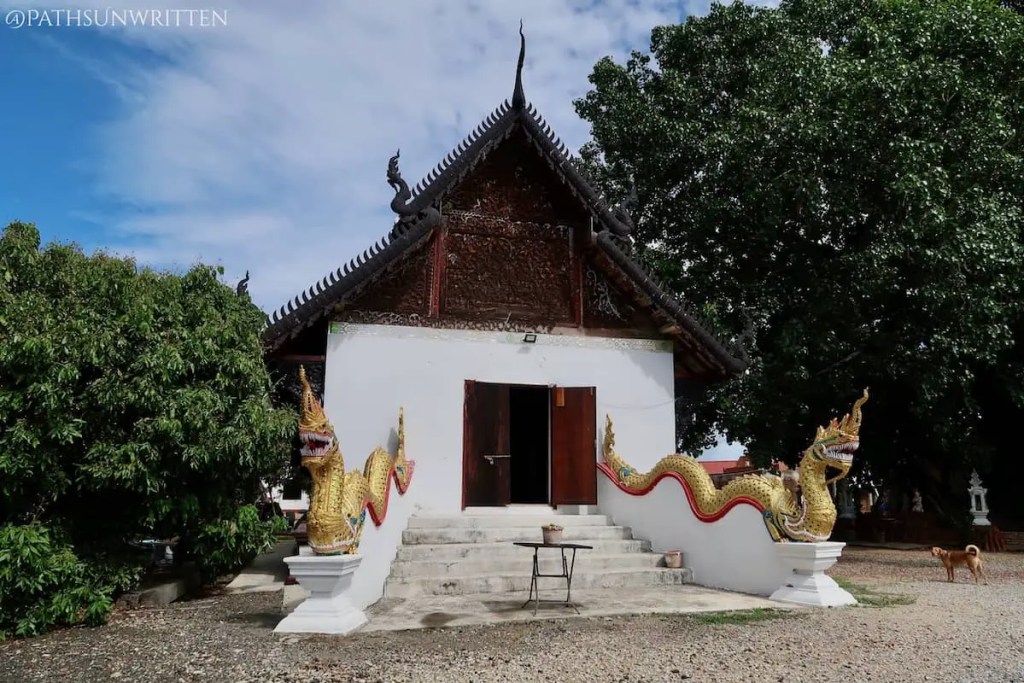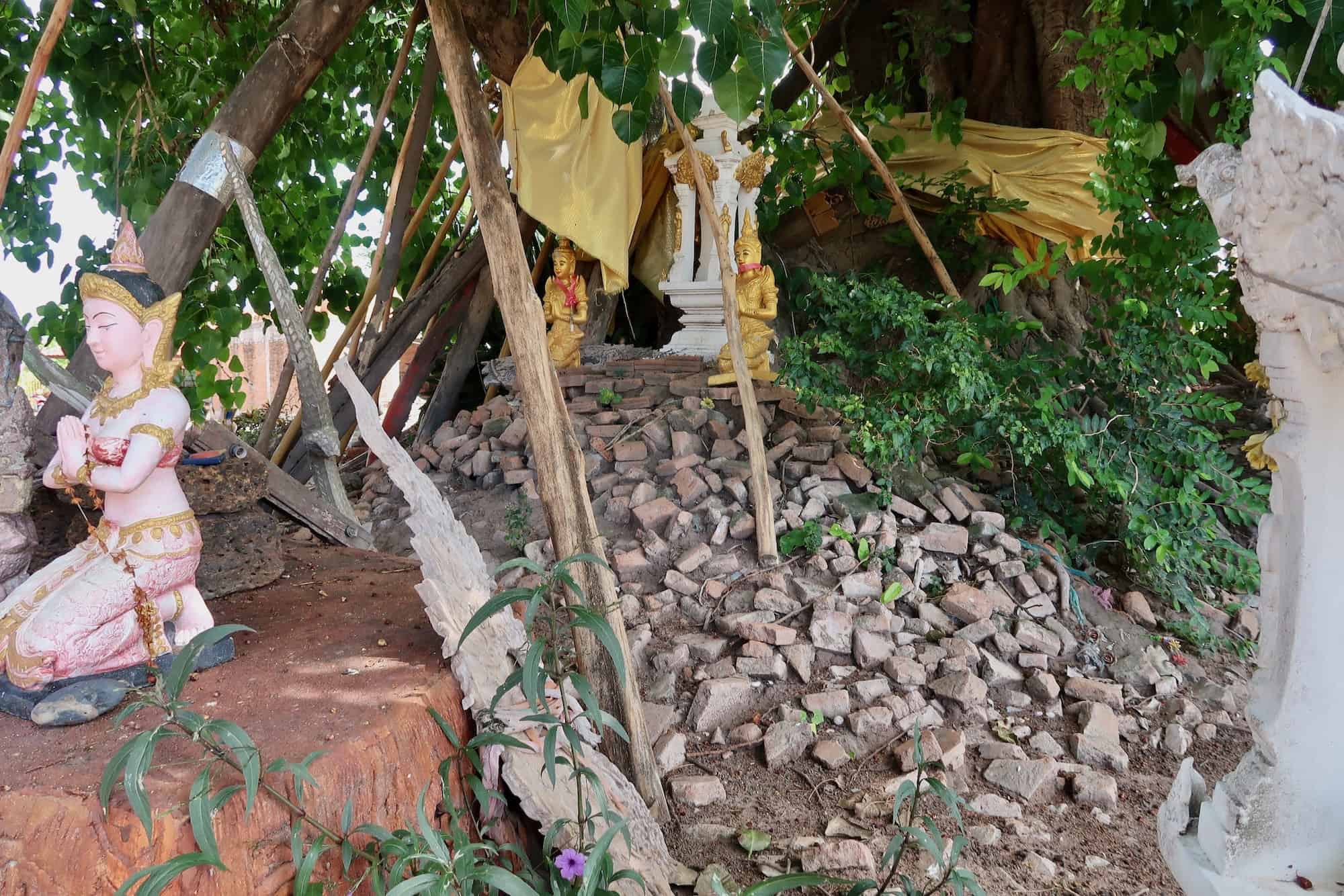Archaeological travel guide to Wiang Mano, one of several ancient cities forming a defensive barrier around Hariphunchai, the precursor to Chiang Mai and the Lanna Kingdom.

Hundreds of years before Chiang Mai, Northern Thailand was ruled by the Hariphunchai Kingdom, based in modern Lamphun. The Mon people of Hariphunchai employed a network of smaller settlements around their capital for defense, which included ruined cities like Wiang Kum Kam, Wiang Tha Kan, and Wiang Mano.
Wiang Mano was a one in a network of defensive satellite towns surrounding the ancient city of Hariphunchai. Due to its proximity to Hariphunchai, it grew to be one of the largest, but declined after the Lanna Kingdom came to power in Chiang Mai. Today, Wiang Mano is only a small temple in empty farmland.
Unlike its counterparts at Wiang Kum Kam and Wiang Tha Kan, Wiang Mano fell into obscurity later in its existence. Here, we will examine the story behind the forgotten town at Wiang Mano and how you can visit for yourself.
Contents
The Story of Wiang Mano

Wiang Mano’s history was inextricably tied to that of the ancient Mon city of Hariphunchai (modern Lamphun). This city was the northern extent of the Dvaravati cultural sphere in ancient Thailand and the capital of the eponymous Hariphunchai Kingdom. Closely surrounding Hariphunchai was a network of smaller towns, of which Wiang Mano was the closest and largest (due to this proximity).
Excavations at Wiang Mano place it tentatively back to 800 CE. Several artifacts excavated from the small town match styles found in Hariphunchai-era art from Lamphun and Wiang Tha Kan. These included some Buddha image moldings that match the style of those at the Rattana Chedi and Ku Kut Chedi in Lamphun, and a bronze Buddha image that matches styles found at Wiang Tha Kan.

The most important of the items found was the Wiang Mano Inscription. This tablet was written in the Old Mon script and used ancient Mon and Burmese languages, matching with seven other inscriptions found in the city of Lamphun.
Unlike Wiang Tha Kan and Wiang Kum Kam, which continued to flourish into the Lanna Period, Wiang Mano seems to have faded in importance, decaying into empty farmland and eventually being subject to looting. This made Wiang Mano a victim of the illegal antiquities market before major excavations could be done at the ancient city.

The areas within the ancient city moat were purchased by a private investor. According to Thai historian Narong Pongpandecha, this investor had the land thoroughly examined in secret for any ancient items of value, such as votive tablets and other artifacts. Pongpandecha goes on to describe that the ancient stupa that once stood over Wiang Mano collapsed due to the illegal excavations underneath it.
The Defensive Satellite Cities of Hariphunchai
The city of Hariphunchai was surrounded by a network of smaller settlements to serve as a defensive buffer and an early alert system for the city. Each of these defensive cities was approximately 20km from the city, or about a 1 day trip from the capital.
While most of these satellite cities have been identified around the modern city of Lamphun, very few traces remain of them. However, some of these cities were later inhabited and expanded by the Lanna Kingdom, preserving them into more recent centuries. Wiang Kum Kam and Wiang Tha Kan are two such cities that still have ruins to see to this day, while Wiang Mano can be traced by its moat and occasional wall remnant, but no other construction from the ancient city exists.
Visiting Wiang Mano

Compared to its nearby counterparts of Wiang Kum Kam and Wiang Tha Kan, very little remains of the ancient settlement at Wiang Mano. If you didn’t know what you are looking for, it would be very easy to miss.
There is no longer any sign of the ancient city wall and the city moat has been relegated to a small irrigation ditch that runs alongside the main residential and rural roads. However, this ancient moat still maintains its rectangular shape, which is how I initially found the site on the map.
Map of Wiang Mano
Wat Sadue Muang วัดสะดือเมือง

The main feature to see in the ancient remnants of Wiang Mano is the modern temple of Wat Sadue Muang (วัดสะดือเมือง), the “temple of the city navel”.
The temple is a small cluster of buildings all centered around a bodhi tree. The majority of the buildings are relatively new, although there is one small white viharn that retains the old style of Lanna temples. Although I tried to get more information on this viharn, there is no historical information available at the site.




The only notably historical monument is a crumbled brick stupa at the base of the bodhi tree. It’s unclear whether this stupa is the ancient principal stupa that collapsed during the illegal excavations, but there are no other signs of any other ruins in the area.
Wat Nong Tong Local Museum วัดหนองตอง
Located on the main road leading from Lamphun, Wat Nong Tong is the main temple of the nearby town (Nong Tong) that also contains a small local museum. According to historian Narong Pongpandecha, this museum at the temple contains a limited selection of artifacts from Wiang Mano. However, I did not know of this museum during my visit, so I cannot confirm this.
Wat Phrachao Leum วัดพระเจ้าเหลื้อม

Not really related to Wiang Mano at all, but the Wat Prachao Leum temple on the eastern edge of the Wiang Mano city moat is a very attractive temple that seems to have some history behind it. The temple also serves as a school for the village.
How to Get to Wiang Mano
GPS Coordinates: 18.61748, 98.9396

While most visitors are likely to approach Wiang Mano from Chiang Mai, it is actually closer and simpler to visit from the modern town of Lamphun (ancient Hariphunchai).
From Lamphun, go 8 km west out of the city on Road 1015 until you reach the small town of Nong Tong, in Hang Dong District of Chiang Mai Province. Wat Nong Tong is the ornate temple in the middle of the town on the main road. Here, there is a local museum to see and the sign that Wiang Mano is 2 blocks directly south.
From Chiang Mai, take either Highway 108 or the riverside Road 4032 south out of the city. Both roads will intersect with Road 1015, which you can then take to Nong Tong and Wiang Mano.
Fast Facts
Fast Facts
Name: Wiang Mano
Where: Chiang Mai, Thailand
Location: 18.61748, 98.9396
Description: Wiang Mano was one of several defensive satellite towns employed by Hariphunchai.
Getting there: Wiang Mano is located in the countryside approximately 18 km to the south of Chiang Mai city, private transportation is needed.
Cost: Free
Glossary
Buddhism
Dharmic religion centered on the belief of karma and release from the cycle of reincarnation. Based on the teachings of Siddhartha Gautama.
chedi
Thai word meaning “stupa”
Chiang Mai
City in northern Thailand and historic capital of the Lanna Kingdom founded by King Mangrai in 1296.
Dvaravati
Mon-Burmese ethnic group based in modern Nakhon Pathom, Thailand. Responsible for the introduction of Buddhism (Theravada sect) to Thailand.
Hariphunchai
Ancient name of Lamphun, Thailand and the historic capital of the Dvaravati Hariphunchai Kingdom.
Hariphunchai Kingdom
Dvaravati kingdom in northern Thailand (c. 750 – 1292 CE) centered in the modern town of Lamphun. Eventually conquered by the Lanna Kingdom.
Lamphun
City in northern Thailand and the historic capital of the Hariphunchai Kingdom.
Lanna Kingdom
Thai kingdom based in northern Thailand and northwestern Laos. Its capitals included Chiang Rai, Wiang Kum Kam, and Chiang Mai.
Mon
Ethnic group originating in Myanmar who established the first civilizations in modern Thailand. The Mon kingdoms in Thailand are collectively referred to at Dvaravati.
stupa
Buddhist monument used to enshrine sacred relics or memorialize important figures. Its dome, bell, or otherwise tower-like appearance is an architectural representation of Mount Meru, the cosmic mountain said to represent the structure of the universe in Hindu-Buddhist cosmology.
viharn
The main worship hall in a Buddhist temple.
wat
Thai word meaning “temple”
wiang
Lanna Thai word for “walled city”
Wiang Kum Kam
The first city established by the Lanna Kingdom in the Chiang Mai valley. Abandoned after successive years of flooding to establish Chiang Mai.
Wiang Tha Kan
A satellite city of Hariphunchai later occupied and expanded by the Lana Kingdom.
Sources
Pongpandecha, Narong and Ken Taylor. “Interpretation of the Cultural Landscape and Heritage Values of “Mae Koong Bok Village”, Tambon Sanklang, San Patong District, Chiang Mai, Thailand.” Suthiparithat Journal, 93rd ed., vol. 30, Dhurakij Pundit University, Bangkok, Thailand, 2016.
“Wiang Mano” display. Hariphunchai National Museum, Lamphun, Thailand.













